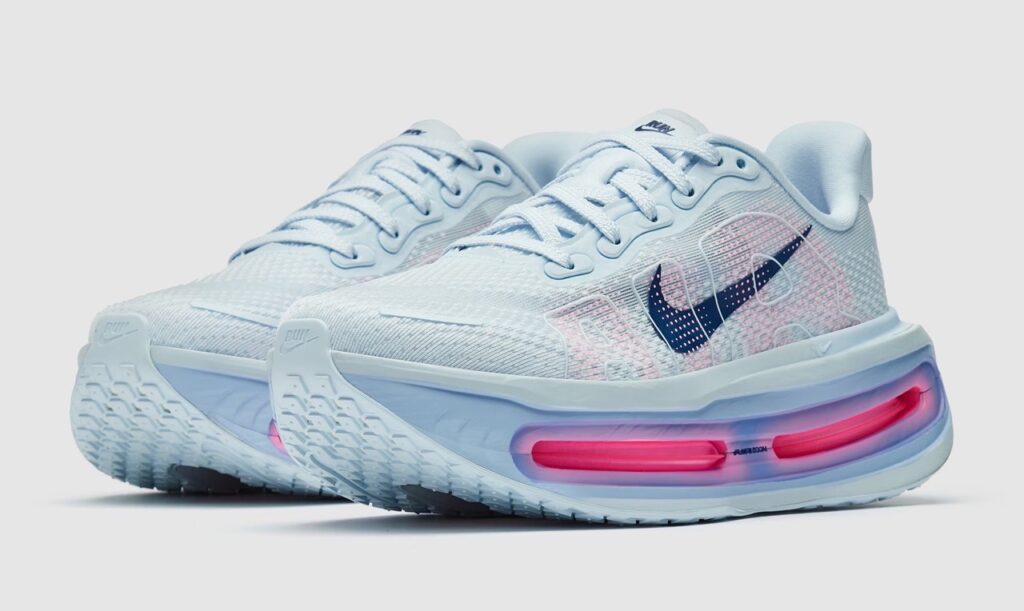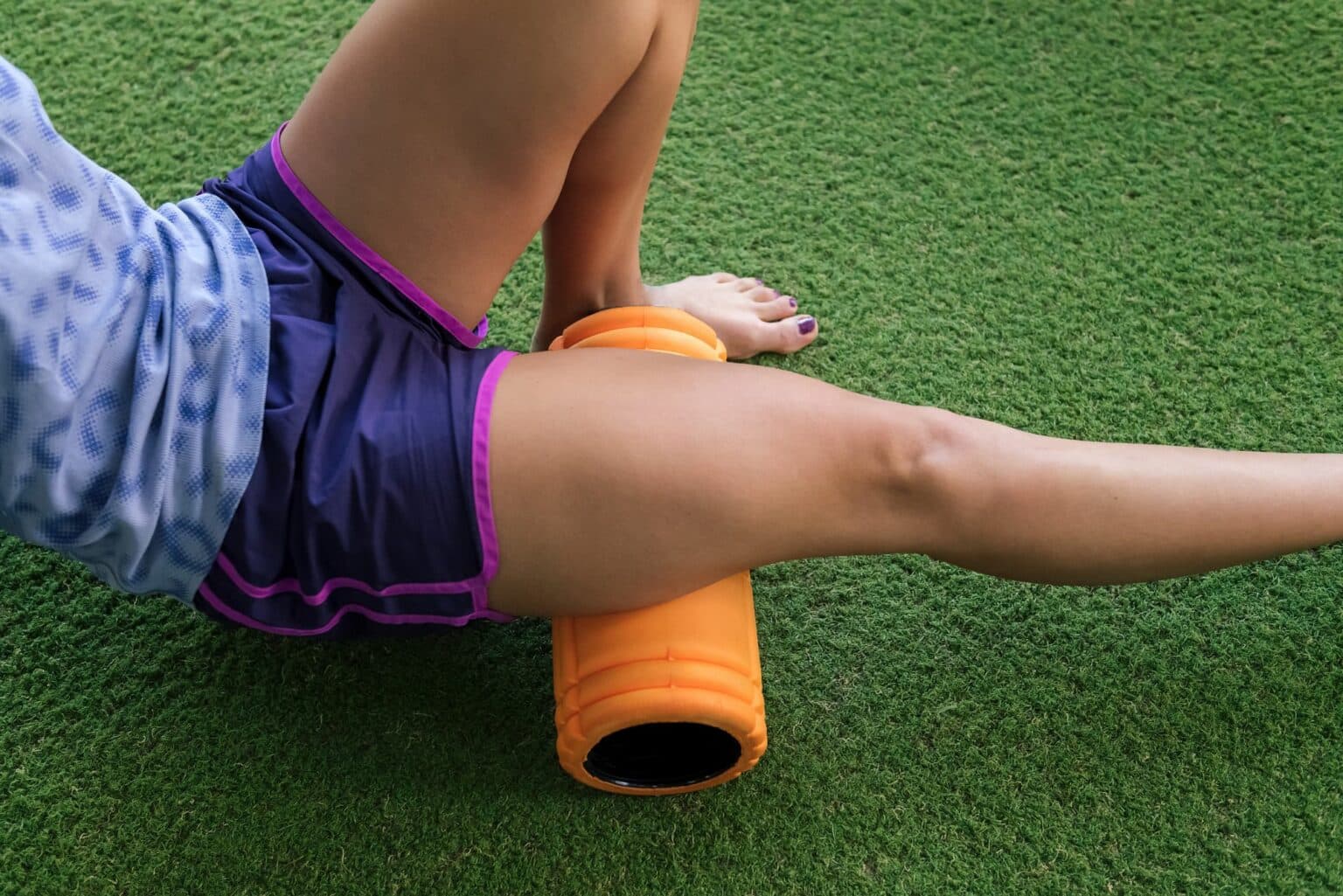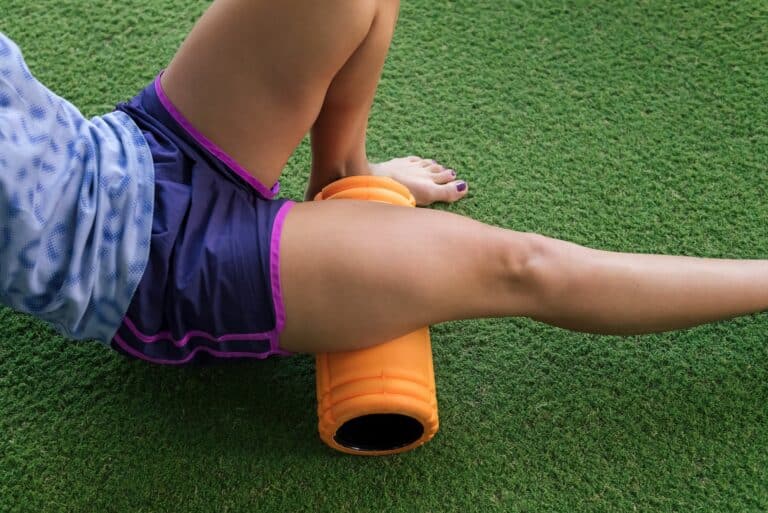


Do you ever experience tight or stiff muscles after your runs? Or do you encounter muscle soreness or heaviness during your training season? If so, you’re not alone! Many runners face these concerns as they strive to reach new fitness levels. The good news is that foam rolling is an excellent solution for runners to alleviate muscle tension.
However, it’s important to keep in mind that muscle soreness or stiffness can result from various factors, including improper stretching, incorrect form, inadequate recovery time, poor nutrition, or even occasional medical issues. While foam rolling can certainly help relax muscle tension, it’s crucial to address these other factors as well. And of course, if you have ongoing concerns, always consult with a doctor.
Are you ready to delve deeper? Let’s discuss foam roller exercises for runners, explore what they entail, the benefits and risks for runners, and identify specific exercises that you can incorporate.

Foam rolling is a physical therapy technique of myofascial release that involves using a foam roller to apply pressure and massage the muscles. Its purpose is to break down muscle knots, or trigger points, and increase blood flow to facilitate healing and recovery. It can also help with scar tissue. Think of foam rolling as a form of self-massage that targets specific areas of the body in need of attention.
In addition to its potential to improve athletic performance, foam rolling claims to enhance muscle and connective tissue flexibility, aid in muscle recovery, and reduce post-exercise fatigue, soreness, and stiffness. It’s like giving yourself a massage, and there is some evidence suggesting that foam rolling can enhance training efficiency and preparation for competition, as well as accelerate post-exercise recovery.
Not only does foam rolling after a workout help alleviate delayed onset muscle soreness (DOMS), but it also improves sprint time, power output, and strength endurance in the days following a challenging session. This can help you stay on track as the week progresses.
Adding foam rolling to your training routine can also help reduce the risk of injury. By regularly releasing tension and tightness in muscles, you are preventing imbalances that can lead to injuries. Additionally, foam rolling before a workout can improve mobility and range of motion, decreasing the chance of straining or pulling a muscle during exercise. You can never have too much foam rolling.
As a runner, you are constantly putting your muscles through stress and strain. This can lead to tightness, stiffness, and even injury if not properly addressed. Foam rolling for runners can be an effective tool for runners to help prevent these issues by promoting muscle recovery and flexibility.
Enhances muscle recovery
Foam rolling helps break up adhesions or knots in the muscles that can lead to discomfort or pain. It also assists in flushing out lactic acid and other toxins that contribute to muscle soreness.
Increases flexibility
Tight muscles can reduce your range of motion and make you more prone to injury. Foam rolling works by releasing tension in the muscles, allowing for increased flexibility and mobility.
Improves circulation
By applying pressure to the muscles, foam rolling promotes better blood flow and oxygen delivery, which is essential for muscle repair and recovery.
Reduces post-exercise soreness
As mentioned before, foam rolling can help alleviate DOMS, making it easier for you to continue with your training plan and reach your fitness goals.
Prevents injury
Regular use of a foam roller can help prevent muscle tightness, and overuse injuries. It’s a proactive way to keep your muscles healthy and functioning properly.
Using a foam roll is relatively simple, but it does require some patience and practice to get the hang of it. Here are some general guidelines for using a foam roller effectively:
Start slow
If you’re new to foam rolling, start with a shorter session and gradually increase the duration. It can be uncomfortable at first, but it should never be painful.
Focus on specific areas
Choose one area of the body to target during each session, such as the inner thigh, hamstrings or calves. Spend 1-2 minutes rolling over that area before moving on to the next.
Roll slowly
Roll back and forth over the muscle slowly, spending extra time on any tight or tender spots.
Apply pressure
Use your body weight to apply pressure to the foam roll, but don’t put all your weight on it. You should be able to control how much pressure you are applying.
Breathe deeply
Deep breathing can help relax the muscles and aid in the foam-rolling process. Take deep breaths as you roll over each area.
Be consistent
To see maximum benefits, practise regular foam rolling, ideally after every workout or at least 2-3 times per week.
The best foam rolling exercises for runners include:
Each of these exercises can be modified or expanded on to target specific areas of the body, such as using a lacrosse ball for deeper muscle tightness or incorporating dynamic movements while foam rolling to enhance flexibility and muscle activation.
Limited on time? Add these five exercises to your post-run routine for improved recovery and endurance. When time is tight, prioritise the essential areas for runners: legs, hips and IT band, which endure the most stress.
Here are 5 key foam rolling exercises recommended and demonstrated by Jack Winyard, a Senior MSK Physiotherapist and Founder from Winchester Physio and Health:
Place the foam roll under one hip and roll back and forth slowly, pausing for a few seconds on any tense spots. Repeat on the opposite side to ease glute muscles.
Position the foam roller under your thighs on your right leg and slowly roll back and forth, stopping at any tight or tender areas. Repeat on the opposite leg to help soothe these large muscles.
Lie on your back with the foam roll under your lower back. Roll slowly up and down, pausing at any areas that feel tight.
Place the foam roller under your thighs and roll back and forth, pausing at any areas that feel tight or tender. Repeat on the opposite side.
Lie on your side with the foam roll placed just below your left hip. Slowly roll down towards your left knee, pausing at any tight areas. Repeat on the opposite side to ease IT band pain.
Lower back pain is a common issue for runners, and foam rolling can be an effective tool in providing relief. Here are some of the most effective foam rolling exercises to alleviate lower back pain:
If you experience severe or persistent lower back pain, it’s important to consult with a healthcare professional for personalised guidance.
Runner’s knee, also known as patellofemoral pain syndrome, is a common issue among runners that can be caused by tight or weak muscles. The pressure created by foam rolling can help alleviate this condition by reducing tightness and improving flexibility in the affected muscles. Targeting the quads, calf muscles, hip flexors, and IT bands with foam rolling exercises can help relieve tension in these areas and reduce strain on the knee joint. So, make sure to incorporate foam rolling into your recovery routine; start with the right knee before moving to the left one. Also ensure that you address any underlying issues that may be causing the condition.
While foam rolling can be beneficial for most people, there are certain individuals who should avoid using a foam roller or consult with a healthcare professional before doing so. These include:
If you fall into any of these categories, it’s crucial to consult with a healthcare professional before incorporating foam rolling into your routine.
It is generally recommended to do foam rolling after a run or workout as part of your cool-down routine. This allows for better muscle recovery and reduces the risk of injury during your activity. However, some individuals may benefit from doing light foam rolling before running to help loosen up muscles and improve their range of motion. As always, it’s essential to listen to your body and experiment to see what works best for you.
Foam rolling may cause some discomfort, especially in areas with tight muscles or muscle adhesions. However, it should not be excessively painful. If you experience severe pain while foam rolling, it’s crucial to stop and consult with a healthcare professional, as this could indicate an underlying injury or issue.
Foam rollers come in various shapes, sizes and densities to cater to different needs and preferences. Decathlon has a wide range of the best foam rollers. Some of the common types of foam rollers include:
Experiment with different types to see what works best for you. Runners often combine a roller with a massage ball to target specific areas.
The Maximo long foam roller is a popular choice for runners. It’s made with high-density material, providing a firm and intense massage that can help release tension and improve the range of motion in the major muscle groups. The extra length also allows for more versatility in exercises and stretches. However, it’s essential to use proper technique and not overdo it when using this foam roller, as it can be more intense on muscle tissue than others. It’s always best to consult with a healthcare professional for personalised guidance on incorporating the Maximo long foam roller into your physical therapy routine.
There is a wide range of affordable foam rollers available in the market, catering to different budget preferences. From basic options to those designed for budget-conscious buyers, you can find options like The Studio Pro EPP 45cm Foam Massage Roller priced at £13.99. This is a softer roller made from high-quality EPP foam and is easily transported in your sports or gym bag. It is great for rolling out your arms, quads, glutes, hamstrings, or calves. It is a great starting option for those new to foam rolling or on a tight budget. While it may not have all the fancy features of more expensive foam rollers, it can still provide effective relief and release tension in the muscles when used as part of a regular foam rolling routine.
With so many different types of foam rollers available, it can be challenging to know which one is right for you. Here are some factors to consider when choosing a foam roller to give you that all-important self-myofascial release:
Density
The density of a foam roller determines its firmness and intensity. Beginners or those with sensitive muscles may prefer a softer, less dense roller, to target those soft tissues, while more experienced individuals may benefit from a firmer roller.
Size and shape
Foam rollers come in different sizes and shapes, with some targeting specific muscle groups, such as the upper body, better than others. Consider your individual needs and what areas of your body you want to focus on before choosing a size or shape.
Texture
As discussed earlier, foam rollers can have smooth or textured surfaces. Textured ones may provide a more intense massage, but they may also be too uncomfortable for some individuals.
Price
Foam rollers can range from affordable basic options to expensive high-tech ones. Consider your budget and how often you plan on using the foam roller before making a purchase.
We recommend the Vyb Pro Foam Roller. While not a cheap option at £129.99, it is highly recommended as one of the best foam rollers by physios due to it being a powerful vibrating rumble roller with 5-speed settings, 1 pulse massage mode and an active remote control. It increases recovery, provides a deeper massage and reduces sore muscles with ease.
Using a foam roller can be an excellent addition to your running recovery routine, providing numerous benefits such as improved flexibility, reduced muscle soreness and tension. With the different types of foam rollers available in the market, there is no shortage of options for you to choose from.
Explore different options and find the best foam roller for you and start those foam roller exercises from physical therapist Jack at Winchester Physio and Health today.
Join our mailing list to stay up to date with the latest UK running events, training tips, and exclusive offers on running products. Rest assured, we value your privacy and would never dream of selling your address. Sign up now…
Share this article
London Winner, Mike Gratton on Tapering for a Marathon The training is done, the last...
An Achilles Tendinopathy or Tendonitis is a structural change to the tendon that attaches the...
Patellar Tendinopathy Syndrome, also known as runner’s knee Patellar tendinopathy, or runner’s knee, is a...
Rest days are an essential part of any workout routine. They provide the body with...
Running is an excellent form of exercise that can benefit your cardiovascular health, strengthen your...
Completing a marathon is a huge accomplishment. After months of training and hard work, crossing...
We’re here to make sure you’re up-to-date with the latest running tips, events and product discounts – we’ve always got your back! Rest assured, we value your privacy and would never dream of selling your address.
BONUS: Sign up today and receive a FREE code for our Sub-4-Hour Marathon Plan